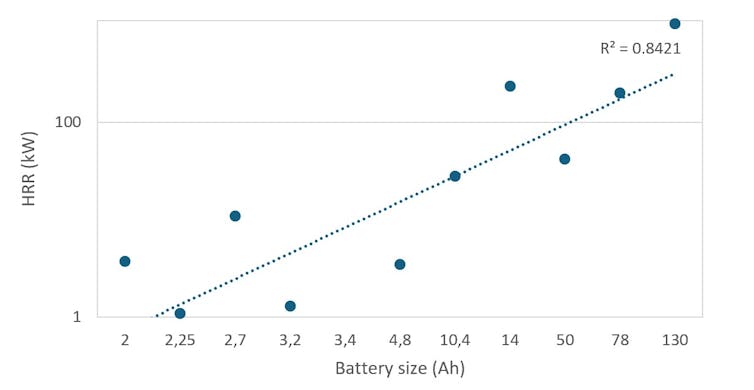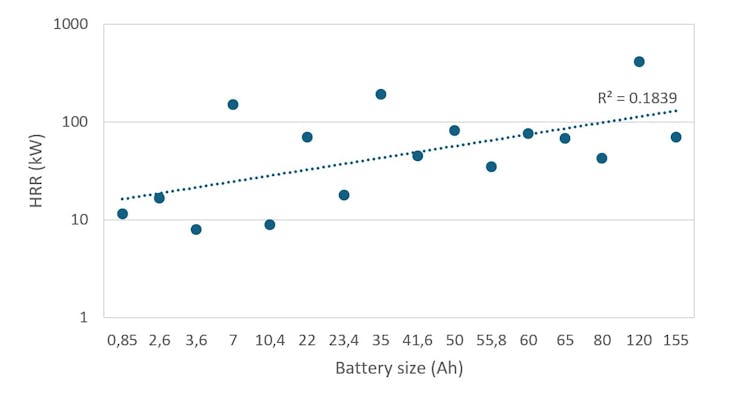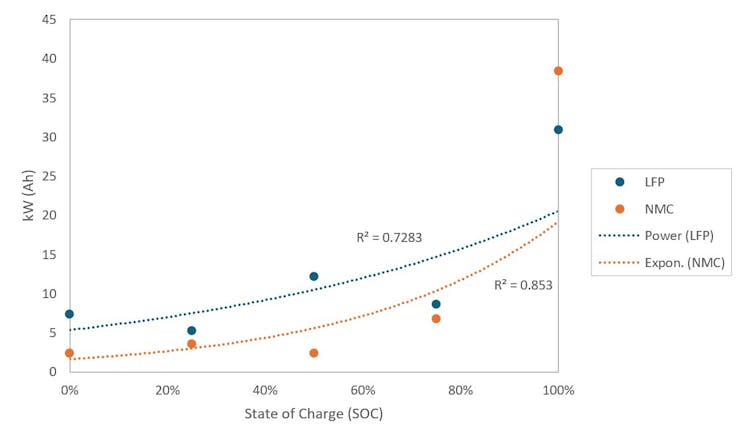By César Martín-Gómez, Universidad de Navarra; Mohd Zahirasri Bin Mohd Tohir, Universidad de Navarra; Victor Debeure, IMT Nord Europe – Institut Mines-Télécom; The Conversation

To better understand the global EV market, we analysed 100 EVs from Europe, Asia, and America, covering various brands and models. The data provided insights into vehicle dimensions, battery types, sizes, and placements. (Pexels photo)
Electric vehicles (EVs) bring not just environmental promise, but also raise critical safety questions – chief among them, the fire risks posed by their lithium-ion batteries. While indispensable for powering EVs, these batteries present unique challenges, especially in confined spaces like parking garages, where the potential for fires carries significant consequences.
At the core of this risk lies the lithium-ion battery (LiB), a powerful energy storage device with considerable vulnerabilities. Several of these batteries’ components pose a fire risk, but the part known as the cathode is critical in this regard. These are typically made of either nickel manganese cobalt oxide (NMC) or lithium iron phosphate (LFP). NMC is more cost-effective, but also more prone to thermal runaway, a hazardous reaction that triggers sudden fires in LiB batteries.
Thermal runaway is a self-accelerating reaction that leads to a rapid temperature increase. It is often caused by overcharging, overheating, damage, or defects, and once initiated, it can cause uncontrollable fires that are difficult to extinguish.
The risk of thermal runaway is mitigated by built-in Battery Management Systems (BMS), which include real-time monitoring, automatic deactivation features, and compartmentalised modules to isolate fires. However, as the range and performance of EVs improves, their batteries are getting bigger, making fire safety a serious challenge, especially in indoor environments.
EV battery Types
To better understand the global EV market, we analysed 100 EVs from Europe, Asia, and America, covering various brands and models. The data provided insights into vehicle dimensions, battery types, sizes, and placements.
The findings showed that around 90% of these vehicles use NMC batteries. While preferred by manufacturers for lower production costs, these batteries are more prone to thermal runaway, making them a major safety concern.
A battery’s weight to efficiency ratio is an important consideration for EV manufacturers, often dictating which battery type is used. However, our comparison of NMC and LFP batteries revealed unexpected results. NMC batteries, at 6.74 kg per kWh, are only slightly heavier than LFP batteries at 6.51 kg per kWh.
This minor difference calls the assumed weight-to-energy advantage of NMC batteries into question, especially given their increased fire risk.
Fire behaviour of NMC and LFP batteries
Our research also looked at the fire-related behaviour of NMC and LFP batteries, the two most common EV battery types.
We looked at data from 24 studies, examining experiments that ignited lithium-ion cells to measure Heat Release Rate (HRR) over time – essentially a measurement of how quickly they burn. While insightful, these tests reflect single-cell behaviour. Fires in full EV battery packs, containing thousands of cells, are far more complex, involving chain reactions and additional energy release from the vehicle itself.
Our analysis did, however, reveal notable differences in fire behaviour between NMC and LFP batteries as capacity increases. At lower capacities, NMC batteries show relatively low maximum HRR, but this spikes dramatically at higher capacities, exceeding 100 kW, as the graph below demonstrates.

César Martín-Gomez, Mohd Zahirasri Bin Mohd Tohir, Victor Debeure
In contrast, LFP batteries exhibit more stable HRR, increasing gradually without reaching NMC’s extreme levels. This suggests that NMC batteries pose greater fire risks at higher capacities, emphasising the need to consider battery type and capacity when assessing EV safety, especially for larger packs.

César Martín-Gomez, Mohd Zahirasri Bin Mohd Tohir, Victor Debeure
Battery charge and fire risk
Beyond just battery type and capacity, the study also explored whether the level of charge in a battery – known as state of charge (SoC) – influences the power released during a fire. The data was divided into five segments – charge levels of 0%, 25%, 50%, 75%, and 100% – and a new metric, kW per Ah, was introduced to account for the Heat Release Rate (HRR) as a function of battery capacity.

César Martín-Gomez, Mohd Zahirasri Bin Mohd Tohir, Victor Debeure
The results were clear: from 0% to 75% charge, fire intensity remained stable, but at full charge, fire strength surged to 31 kW/Ah for LFP batteries and 38 kW/Ah for NMC batteries. This increase aligns with real-world incidents, as many fires occur during vehicle charging.
This highlights the importance of effective fire prevention systems at parking lot charging stations, particularly underground, to mitigate risks associated with charging EVs, especially those with high-capacity NMC batteries.
So is it safe to own an EV?
The answer is yes, but only if certain safety measures are followed. Systemic measures, like advanced fire suppression systems in public spaces, are critical, but individual EV owners also play a vital role in minimising risks. Owning an EV with a home-charging setup offers great convenience, but it’s essential to address potential hazards.
Following manufacturer guidelines, conducting regular battery health checks, and equipping your garage with fire protection tools like electrical-rated extinguishers and fire blankets can significantly enhance safety. By taking these proactive steps, we can embrace the future of cleaner transportation with confidence and peace of mind.![]()
César Martín-Gómez, Catedrático en instalaciones y sistemas energéticos en arquitectura y urbanismo, Universidad de Navarra; Mohd Zahirasri Bin Mohd Tohir, Investigador postdoctoral en ingeniería de seguridad contra incendios, Universidad de Navarra, and Victor Debeure, Industrial Engineer, IMT Nord Europe – Institut Mines-Télécom
This article is republished from The Conversation under a Creative Commons license. Read the original article.





















